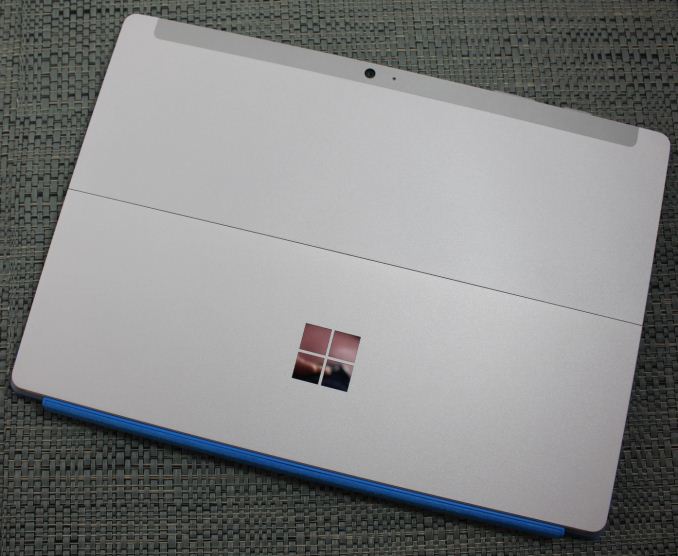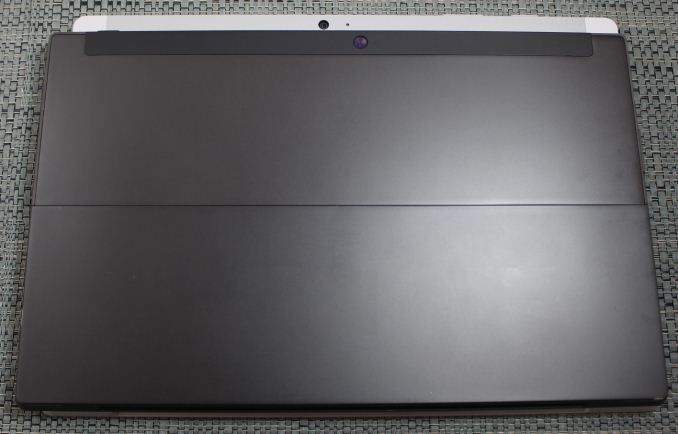The Surface 3 Review
by Brett Howse on May 4, 2015 9:00 AM EST
The Surface lineup for Microsoft has been extremely interesting to watch. What first launched in October 2012 as the Surface RT has been constantly iterated upon, and of course the Surface Pro line has evolved even faster. Surface Pro 3 has finally provided Microsoft with something that critics and consumers alike seem to have bought in to, and sales have been very strong since the Pro 3 was launched on May 20th 2014. However there has always been questions about the “consumer” version of Surface. Surface RT was, frankly, a sales disaster. The much improved Surface 2 fixed many of its shortcomings, but certainly did not set the world on fire. So now we have the third generation Surface, aptly named the Surface 3. There are a pile of changes that Microsoft has made to this generation of device, and obviously their hopes are that Surface 3 will be as popular as the Surface Pro 3 has been, but extending the device back down to a lower price point.
That price point is important. As much as the Surface Pro 3 has gained its share of fans, it is far from cheap. The most inexpensive model starts at $799, and for that you still do not get the keyboard. Surface 3 moves that bar down significantly, and the starting price is the exact same as the original Surface RT, at $499. Microsoft had to trim down the Pro model to hit this price point, but the cuts were well placed.
 Surface RT compared to Surface 3
Surface RT compared to Surface 3
I think looking at the Surface 3 in a vacuum would be improper, since the device now is really an evolution of the previous two Surface models. From a build quality standpoint, the original Surface RT was top notch, with its VaporMg case, the revolutionary kickstand, and high attention to detail for all of the aspects from buttons to display. I think in 2015 it is pretty obvious what the shortcomings of the Surface RT were though. Performance was less than acceptable with the Tegra 3 SoC on board, and Surface RT was handicapped with the confusingly named Windows RT operating system and the lack of software compatibility that goes with using an ARM CPU instead of traditional x86. Surface 2 fixed the performance issue by moving to NVIDIA’s Tegra 4 SoC, and while not the outright fastest tablet chip, it was at least in the ballpark. However it kept the Windows RT operating system at a time when everyone else had abandoned it.
Surface 3 has fixed that final issue and at the same time made some amazing improvements to the overall design and feel. Full x86 Windows is on tap, for better or for worse, and powered by a brand new SoC. This must be a special moment in history where a Microsoft built device is the launch vehicle for a brand new product from Intel. The Surface 3 is powered by the 14nm Intel Atom x7, in this case the x7-Z8700 model which is the current top of the line Atom processor. Codenamed Cherry Trail, this is the massaged Bay Trail cores now built on Intel’s now mature 14nm FinFET process, and they include the same GPU cores as Broadwell.
| Microsoft Surface Comparison | |||
| Surface 3 (Base) | Surface 3 (High) | Surface 2 | |
| Size | 10.52 x 7.36 x 0.34 inch 267 x 187 x 8.7 mm |
10.81 x 6.79 x 0.35 inch 275 x 173 x 8.8 mm |
|
| Weight | 1.37 lbs - 622 g | 1.49 lbs - 675 g | |
| Display | 10.8-inch ClearType Full HD Plus 1920x1280 resolution, 3:2 ratio 10-point multi-touch Surface Pen Support |
10.6-inch ClearType Full HD 1920 x 1080 resolution, 16:9 ratio 5-point multi-touch |
|
| Battery | 28 Wh, 13 W AC Adapter | 31.5 Wh, 24 W AC Adapter | |
| Storage | 64GB | 128GB | 32GB or 64GB eMMC |
| RAM | 2GB | 4GB | 2GB |
| CPU | Atom x7-Z8700 Quad Core 14nm 1.6 GHz Base Frequency 2.4 GHz Burst Frequency |
NVIDIA Tegra 4 4x ARM Cortex-A15 @1.7GHz |
|
| WiFi | Marvell 802.11ac + BT 4.0 LTE Models at a later date |
802.11n + BT 4.0 | |
| Ports | USB 3.0, Mini-DisplayPort, microSD, Micro USB charging, 3.5mm Headset Jack |
USB 3.0, micro-HDMI, microSD, proprietary charging | |
| Software | Windows 8.1 Office 365 Personal with 1TB OneDrive (1-year) |
Windows RT 8.1 Office 2013 RT Home & Student Edition |
|
| Front Camera | 3.5 MP | 3.5 MP | |
| Rear Camera | 8.0 MP with Autofocus | 5.0 MP | |
| Operating System | Windows 8.1 64-bit | Windows RT 8.1 | |
| Warranty | 1-year limited | 1-year limited | |
| Price | $499 | $599 | $449 |
In addition to the new SoC, Surface 3 can be purchased with up to 128 GB of eMMC storage, and the higher storage models also come with 4 GB of RAM. This compares to the base model which is 2 GB of RAM and 64 GB of storage, which is already one of the big improvements Microsoft has made with Surface. 32 GB of storage on a Windows tablet is really the bare minimum required, and the move to 64 GB as the base is going to make this tablet far more usable. You can of course add more storage with a micro SD card, but until Windows gets the great SD card support from Windows Phone, it still means that you need to manage your storage more than you should have to.
There are so many changes with the Surface 3 that really, this is likely the Surface that most people wanted from day one, but did not know it. First up is the new (again) kickstand.










265 Comments
View All Comments
Luc K - Thursday, May 7, 2015 - link
Battery life of both Yoga 3 Pro and the Asus T300 Chi are not anywhere close to this one.Then again completely different kind of devices.
This Atom CherryTrail CPU is actually newer than Core M but different kind of line of CPU's obviously.
MattVincent - Tuesday, May 5, 2015 - link
The 64gb doesn't bother me but the 2gb of ram seems like its just cutting corners. Price goes up way to fast once you add on the accessories. They shouldn't be charging for the pen.TEAMSWITCHER - Tuesday, May 5, 2015 - link
Ya think? I just checked MacMall.com, and I can get a 2015 11" MacBook Air for $819. That includes an Intel Core i5 CPU with HD6000 graphics, a decent keyboard, industry leading trackpad, PCIe SSD, Thunderbolt port, 2 USB 3.0 ports, and MagSafe Power. The display on the Surface might be a little better, but the atom CPU and archaic storage are very more worse.I own an 2013 11" MacBook Air and have found it to be a very capable machine. The screen is small, but workable thanks to OS X's excellent full-screen app / virtual desktop implementation. When I'm in my office, I connect it to my 27" monitor, Apple Keyboard, & Magic Mouse and use it like any other desktop.
The Surface 3 possesses only one redeeming quality - a Pen. How bad are you willing to let Microsoft screw you over for a Pen? If the answer is "brutally" then buy a Surface 3.
xthetenth - Tuesday, May 5, 2015 - link
The screen isn't just small, it's wildly archaic with a low res and bad panel technology. I'd also love to see you try to use the air as a tablet. If you don't need a tablet, don't get a tablet, get an ultrabook.RafaelHerschel - Tuesday, May 5, 2015 - link
I considered a MacBook Air, but the screen was unacceptable at the price point. I'm sure that will be rectified in the future, but for now there are inexpensive Windows alternatives with much better screens.AnyOny24 - Wednesday, May 6, 2015 - link
If you want to talk about that price point you should talk about the Pro 3 core i5 which supports tablet mode / touch, the same pen you're talking about, bigger / better screen... silly comparison.damianrobertjones - Wednesday, May 6, 2015 - link
Or I can just buy the S3 along with a £20 BT keyboard.BlueBomberTurbo - Thursday, May 7, 2015 - link
Actually, the screen on the Surface 3 is the best portable screen you can get next to maybe the new Macbook. The Air's screen was terrible for anything requiring any level of color accuracy. You know, the artsy stuff that you can apparently only do on a Mac.The other redeeming qualities are its size and weight. I know I bought it specifically for those and the screen, as a portable workstation for my photography. When you cram lots of lenses and a couple camera bodies in your backpack, you're already hauling around a good amount of weight. A well-spec'd laptop certainly isn't going along for the ride, too.
lokhor - Tuesday, May 5, 2015 - link
Worst thing about the dock on the SP3 is that the angle cannot be adjusted so its virtually useless if you want to have it set up as a secondary screendigiguy - Tuesday, May 5, 2015 - link
Laughing out loud at the "bulky and heavy" comment. This tablet weights less than the ipad 4 and I was not hearing people call that bulky and heavy.... Better, this tablet has a whole inch more screen surface that the ipad.... But this is partly the fault of reviewers that call this a 10 inches device, like the ipad.... Why the ipad, that is 9.7 inches, is 10 inches and this one, at 10.8, is not 11 inches? Increase the screen size of the air and the weight will also go up, while still being a bit lighter, not to mention ipad 4 and below.I have a 600g 10.1 inches windows tablet and it feels very light and pleasant to hold with one hand, just awkward with its 16:9 ratio. The surface will feel more balanced.
Concerning storage speed, the 128GB model offers better performance (see this accurate review for more details http://www.notebookcheck.net/Microsoft-Surface-3-T...
Having said that, this is the performance with the encrypted SSD. Personally I decrypted the SDDs in all my tablets (Surface pro 3, HP Stream 8, etc.) and the performance, especially the sequential one, has significantly increased.